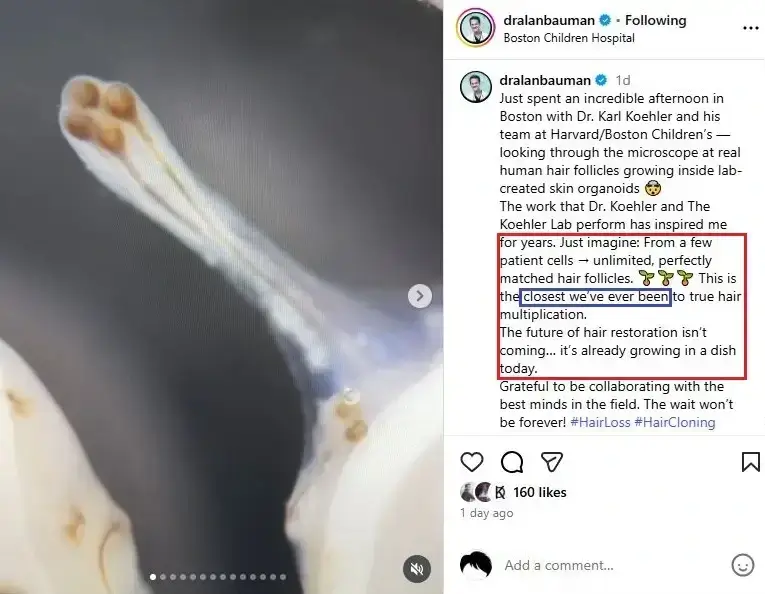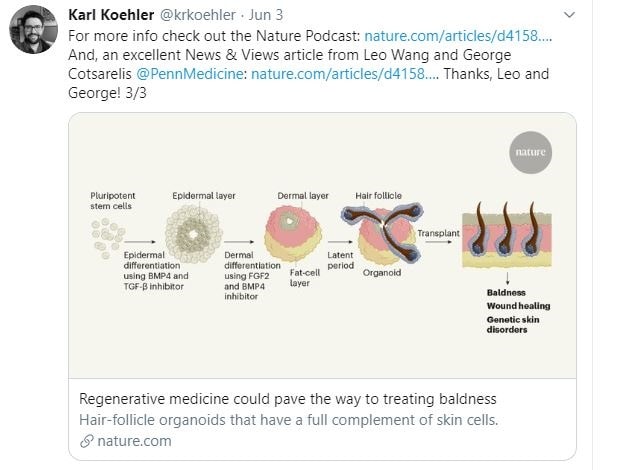Update: November 23, 2025
Hair Multiplication from Koehler Lab
It looks like Dr. Karl Koehler and his lab in Boston are still going strong. Some interesting photos and very optimistic words about how close they are to “true hair multiplication” from hair transplant surgeon Dr. Alan Bauman. He visited the Koehler Lab at Harvard University near Boston yesterday.

Update: October 16, 2024 — Dr. Koehler is one of the main authors of a new study examining the prenatal human skin atlas (including associated hair follicle growth).
Update: January 18, 2022 — Dr. Koehler is covered in detail in the second half of a new article in MIT Technology Review.
“I think people will go pretty far to get their hair back. But at first it will be a bespoke process and very costly.”
June 4, 2020
Pluripotent Stem Cells and Hair Growth
Yesterday a very important study was published in Nature Magazine. It is titled “Hair-bearing human skin generated entirely from pluripotent stem cells”. The scientists behind this research took 6 years to complete and publish their work.
The study has numerous co-authors from a few medical centers and universities based in the US. The lead author is Dr. Jiyoon Lee, while the correspondence author is Dr. Karl Koehler. The latter works at Boston Children’s Hospital as well as Harvard Medical School. Moreover, Dr. Koehler’s lab has its own site, on which he published a post about these findings.
Update: The podcast for this news is here.
Dr. Karl Koehler via Twitter

From Skin Organoids to Hair
In this latest research, undifferentiated human stem cells were successfully coaxed into developing skin-like organoids in vitro. When these human-derived structures were grafted onto immuno-compromised bald mice, the rodents produced robust (albeit shorter length) hair.
Note that in 2015, Dr. Alexey Terskikh and his team used pluripotent stem cells from humans to create dermal papilla type cells. These were then injected into hairless mice and grew hair.

In this new work, the scientists generated near-complete skin organoids first that ultimately resulted in pigmented hair. The skin cells grew in a sphere and were “fed” with various chemicals and growth factors (such as BMP4 and FGF2) for 4-5 months. Both the dermis and epidermis skin layers were grown successfully.
If this work goes through successful clinical trials, it will essentially mean a cure for hair loss. Nevertheless, the global media has largely ignored this research, with the UK’s Mirror being a notable exception. And as always, the Daily Mail too.
Cotsarelis Rises Again
Prolific blog commentator “MJones”‘ favorite hair loss researcher and fellow “Alexander the Great” progeny Dr. George Cotsarelis has been missing in action of late. However, this new research is so significant, that Dr. Cotsarelis and Dr. Leo Wang wrote a detailed article summarizing it in Nature Magazine.
Per the two doctors, this study represents a major step towards a cure for baldness in humans. They are confident that this research will eventually see its promise realized. This technique makes it possible to produce human hair without having to take any donor hair from the human.
Moreover, individuals who have major wounds, scars and genetic skin diseases will all benefit from revolutionary new treatments based on this research. That is if it comes to clinic of course.
In these times of pandemics, protests and riots, it is great to see Dr. Cotsarelis’ still unabated optimism.
Further reading:
An excellent 2019 paper summarizing tissue engineering strategies for human hair follicle regeneration.
Also check out my June 2023 post on hair regeneration via induced pluripotent stem cells.

